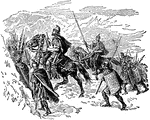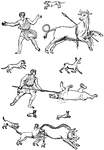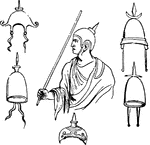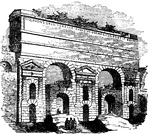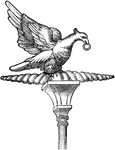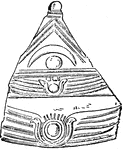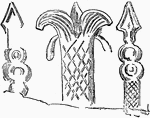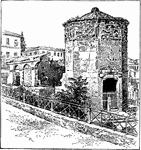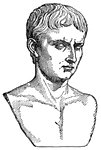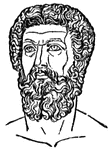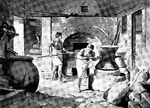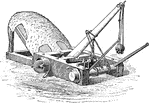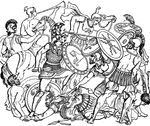This ClipArt gallery offers 396 images of the Roman Empire including culture, people, everyday life, coats of arms, and more. See also the Roman Coins, Roman Architecture, Roman Ornament, Roman Mythology, and Ancient Roman Musical Instruments ClipArt galleries.

A Frankish Chief in Full Armor
A chief of a Frankish tribe, wearing full battle armor. He stands looking to his right holding a long…

A Roman Soldier, or Legionary, with a Short Javelin and Shield
Illustration of a Roman soldier, also called a legionary, carrying a shield, short sword, and a short…
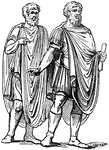
Abolla
A cloak chiefly worn by soldiers, and thus opposed to the toga, the garb of peace. The abolla was used…
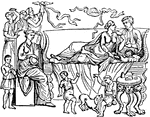
Accubatio
"The act of reclining at meals. The Greeks and Romans were accustomed, in later times, to recline at…
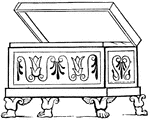
Acerra
"The incense-box or censer used in sacrifices. The acerra was also a small moveable alter placed before…
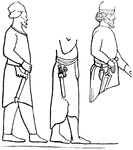
Acinaces
"A Persian sword, whence Horace speaks of the Medus acinaces. The acinaces was a short and…
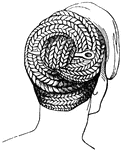
Acus
"A needle, a pin. Pins were made not only of metal, but also of wood, bone, and ivory. They were used…

Flavius Aetius
Flavius Aetius (396-454) was a Roman general of the closing period of the Western Roman Empire.
!["In order that [Alaric's] body might be saved from the gaze of the vulgar and the rage of his foes, he gave direction that it should be buried in the bed of the river Busentinus."—Ridpath, 1885](https://etc.usf.edu/clipart/78900/78952/78952_alaricburial_mth.gif)
The Burial of Alaric in the Bed of the Busentinus
"In order that [Alaric's] body might be saved from the gaze of the vulgar and the rage of his foes,…

Alexander
Alexander defeating the Persians. This is an illustration of the Alexander Mosaic, found on the floor…

Amice
An amice was a loose fitting garment worn by Romans over their tunics; it was also worn by priests and…

Roman Amphora
This Roman Amphora is unpainted made out of red clay. The neck of this vase is narrow with a thick rim.

Roman Amphora
This Roman Amphora is an unpainted vase made out of yellow clay. It was found in the area near Aquileia,…
Roman Amphora
This Roman Amphora is made out of iridescent glass and was found in Pompeii, Ancient Rome.
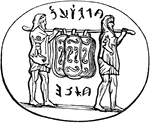
Ancile
"Ancilia carried by Salii. The sacred shield carried by the Salii, and made of bronze. The original…

Antinous
"It was during Hadrian's sojourn in this country that his favorite, the beautiful Birthynian named Antinous,…
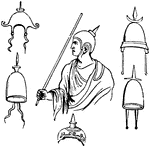
Apex
"A cap worn by the flamines and salii at Rome. The essential part of the apex, to which alone the name…

Arma
"Homer describes in various passages an entire suit of armour, and we observe that it consisted of the…
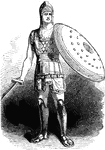
Arms and Armor
The image of a Roman legionnaire. He is equipped with a dense breastplate, a helm, a large round shield,…

Auger
"Among the anceient Romans, a functionary whose duty it was to observe and to interpret, according to…
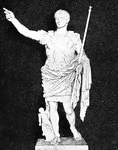
Augustus
"Augustus ruled for about forty-two yeras, that is, from 27 B.C. to 14 A.D., and this period is known…

Sculpture of Augustus
Augustus, born Gaius Octavius Thurinus, was adopted by his great-uncle Julius Caesar in 44 BC, and between…

Antique Roman balance from Pompeii
This antique Roman balance from Pompeii has one pan that hangs from a rod.
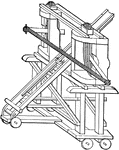
Ballista
The Ballista is a device for throwing large darts very accurately. The Roman Ballistas threw stones…

Balneum
"Balneum or balineum signifies, in its primary sense, a bath or bathing vessel, such as most Romans…
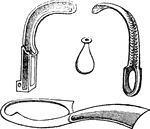
Balneum
"Balneum or balineum signifies, in its primary sense, a bath or bathing vessel, such as most Romans…

Ancient Roman Baths
Bathing was an important part in Ancient Roman culture and society. In Germany there are These Roman…

Eagle Bearer
An eagle bearer from the Roman Empire. The eagle was made of precious metal and was the symbol of the…

Roman Bedstead
This Roman bedstead had a Pompeian vase-painting. It included a head and foot board. It was made out…
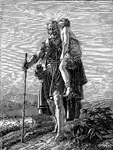
Blind Belsarius
Belsarius was ordered to have his eyes put out, and was reduced to a homeless beggar.

A Bishop Sitting on a Bishop's Throne Called a Cathedra
Illustration of a bishop sitting on an ornately decorated cathedra. A crosier, pastoral staff, rests…
